Homegrown blueberries are one of my favorite summertime snacks, with a sweet-tart flavor that’s perfect for enjoying out of hand, blended into a pancake batter, baked in a pie, or cooked down and made into jam.
Though growing blueberries at home isn’t for everyone, given the right conditions, this could be the perfect crop to add to areas of the garden with well-draining acidic soil (think: near the stand of pine trees) and full sun.
Dwarf varieties can even be grown in containers on the patio. And pink or white flowers and colorful fall foliage adds ornamental garden interest as well.

We link to vendors to help you find relevant products. If you buy from one of our links, we may earn a commission.
Native to North America, the first hybrid cultivar was developed in New Jersey at the turn of the twentieth century by Elizabeth White and Fred Coville, and they’ve been hugely popular ever since.
We’ve compiled a list of some of our favorite cultivars, suited for a variety of climates and spaces:
Best Blueberry Varieties to Grow at Home
1. Biloxi (Zones 8-10)
This Southern highbush type is a relatively new cultivar, developed at Mississippi State University. And it’s great for low-chill or even no-chill environments.
That’s right – even if you live in a growing zone without enough nights with temperatures below freezing to grow other types of fruit, ‘Biloxi’ may do well in your climate.
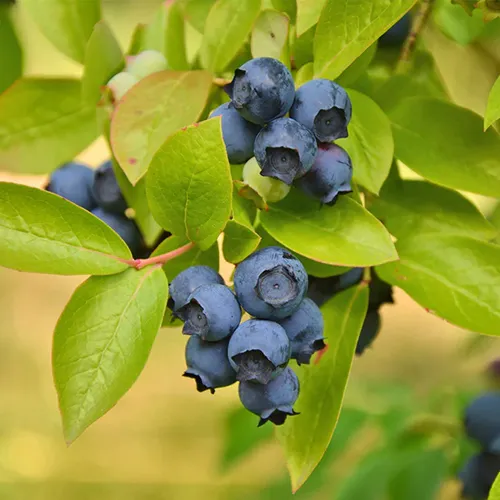
It actually grows better with under 150 chill hours per season, though you can still expect some fruit if you plant it in a cooler climate.
With a vigorous growth habit and medium-sized berries that are ready to harvest early in the season, plant in acidic soil amended with pine mulch and peat, in an area with full sun.
You can find ‘Biloxi’ plants in two-gallon pots available from Fast Growing Trees.
2. Bluecrop (Zones 4-7)
The most popular variety in the world!
An upright, open growing, spreading Northern Highbush variety, you can expect ‘Bluecrop’ to grow at a medium speed, with a mature height around five to six feet and a spread of four to six feet.
With a medium growth rate, green leaves that change to red on red stems in the fall provide ornamental appeal through the winter.
Most importantly, the firm, medium-sized light blue fruit is known for its excellent flavor, and berries are resistant to cracking.
You can expect consistent yields and continuous production from this mid-season cultivar, which produces flowers starting in May, and a harvest by early August.
This type prefers organically rich soil, with constant moisture and good drainage, and is known to succeed in areas of the garden where other edibles struggle. Known for its disease resistance, ‘Bluecrop’ is drought tolerant when mature.
This variety is known for having shallow roots, so work carefully if you are doing any cultivation or tending to other plantings in the area.
Find ‘Bluecrop’ in #1 containers available from Nature Hills Nursery.
3. Blueray (Zones 4-7)
With sweet, light blue berries that begin to ripen in early to mid-July, this Northern Highbush cultivar is known as a great type to plant with other highbush types for cross-pollination.
Green foliage turns scarlet in the fall, with a five- to six-foot maximum height and three- to four-foot spread.
The mid-season ‘Blueray’ berries are known for being crack resistant, with a strong blueberry flavor and aroma, and firm flesh.
This variety is known for overproducing, which means it will naturally set an abundance of fruit that can stress the plant, so it needs to be pruned regularly and carefully.
‘Blueray’ is available at Burpee.
4. Brightwell (Zones 6-9)
This is one of the larger cultivars, growing to a max height of eight to 10 feet with an almost equal spread, and large berries.
A rabbiteye type, meaning it has berries that change in shade from pink to blue as they mature.
You can expect large harvests from this self-fruiting variety – so you can plant just one if you wish, though you can always expect higher yields with a buddy to cross pollinate. Tifblue or Climax are recommended.
Many cultivars require attentive mulching and soil amendment, but this variety isn’t as picky, and is hardy in the face of late freezes.
‘Brightwell’ can tolerate partial sun, though full sun is always best for fruit-bearing plants. It produces attractive pink flowers, and green foliage that will turn shades of red and orange in the fall.
Pick up ‘Brightwell’ plants in #1, #3, and #5 containers from Nature Hills Nursery.
5. Legacy (Zones 5-8)
This Northern Highbush variety is known for the sweetness and excellent taste of its large berries, according to the New Jersey Agricultural Experiment Station of the USDA.
Leaves turn crimson in the fall, and the disease-resistant plants can reach max heights over six feet at maturity, with a spread of three to six feet.
With high yields and a late mid-season harvest, ‘Legacy‘ fruit stores well, and plants exhibit vigorous, upright growth.
It will even keep some of its leaves through mild winters, for added garden interest.
‘Legacy‘ is available from Nature Hills Nursery in #2 and #6 containers.
6. Pink Icing (Zones 5-10)
With a mature height of three to four feet and an upright mounded spread of four to five feet, the blue berries are ready for harvest mid-season, and known for their robust flavor.
New growth in the spring adds ornamental interest, with leaves in varying shades pink, mixed with blue and dark green, and an attractive turquoise blue hue in winter.

‘Pink Icing’ grows best in full sun, but can tolerate some shade.
Relatively low maintenance, you won’t have to do a lot of pruning with this self-pollinating dwarf variety. And grown under the right conditions, the fast-growing plants can live for 20 years.
Find ‘Pink Icing’ plants in two-gallon containers from Green Promise Farms via Amazon.
7. Pink Popcorn (Zones 4-8)
One of the more unusual cultivars, these blueberries are actually pink when mature, with the same flavor that you’re used to. And they freeze well, too.
Reaching four to five feet in height and spread when mature, ‘Pink Popcorn’ is a compact Northern Highbush variety that prefers peaty, acidic soil and even moisture.
This cultivar grows at a medium speed, with white flowers and dark green foliage that turns red in the fall.
Fruit is ready for harvest early to mid-season, and you can expect a lot of berries from these hardy plants. They are easy to care for, disease resistant, and self-pollinating.
You can pick up ‘Pink Popcorn’ plants from Nature Hills Nursery.
8. Powder Blue (Zones 6-9)
With a mature height and spread of six to 10 feet, ‘Powder Blue’ is a hardy cultivar with an upright growth habit and medium growth rate.
White flowers bloom in late spring to early summer, which provides added protection from late freezes. And green foliage changes to red and yellow in the fall.
This is a rabbiteye type is regarded as sweeter than other varieties, with harvests later in the season than you’ll find with other cultivars.
Expect a high yield of large, light blue fruit in clusters of up to 50 berries each, perfect for canning. They also hold up well to freezer storage.
Generally long lived, plant ‘Powder Blue’ with other cultivars for cross-pollination.
Nature Hills Nursery carries ‘Powder Blue’ in #1, #3, and #5 containers.
9. Sunshine Blue (Zones 5-10)
This cultivar stands out in terms of ornamental value, with pink flowers in the spring, and attractive blue-green foliage that turns burgundy red in the fall.
Not to mention the sweet and delicious medium-sized fruit that’s ready for a mid- to late season harvest in late July and August.
A dwarf Southern highbush variety, ‘Sunshine Blue’ grows to a maximum height and spread of three to four feet. It’s easy to prune, and can even be grown in containers, so it’s perfect for small space gardeners).
‘Sunshine Blue’ can tolerate a variety of soils (as long as they drain well) and even some shade, though full sun is preferred for maximum yields. Plant with another variety to keep your bases covered, for cross-pollination.
This cultivar is said to tolerate soil with a high pH better than other varieties, and it’s known for vigorous growth in warmer climates, with an upright, compact habit.
Find ‘Sunshine Blue’ in #1 and #5 containers available at Nature Hills Nursery.
10. Top Hat (Zones 4-7)
Developed at Michigan State University with a half-high growth habit, at maturity you can expect ‘Top Hat’ to reach a total height of 18 to 24 inches, with a spread of one to two feet.
With white flowers in the spring, its leathery green leaves turn shades of bronze in the fall.
These petite plants are great for small spaces, and can be grown in pots – we’ve even heard that some gardeners have experimented with trimming this cultivar into a tidy decorative bonsai! ‘Top Hat’ can also be grown as a border plant.
Though they prefer full sun, ‘Top Hat’ plants can tolerate partial shade, and they will grow at a medium speed in well-drained soil.
This self-pollinating dwarf variety can be grown on its own, and despite its small size, it produces full-size berries that are ready for harvest in July and August.
Head to Nature Hills Nursery to pick up ‘Top Hat’ in #1 containers.
A Delicious Harvest, Grown at Home
With so many tempting options to choose from, it’s going to be hard to pick just one. Fortunately, you don’t have to!
Planting more than one variety of the same type (i.e. highbush or rabbiteye) is recommended, to ensure large harvests.
You’ll need to be patient, since production won’t reach its peak until plants are at least a few years old, but this delicious fruit is worth the wait.
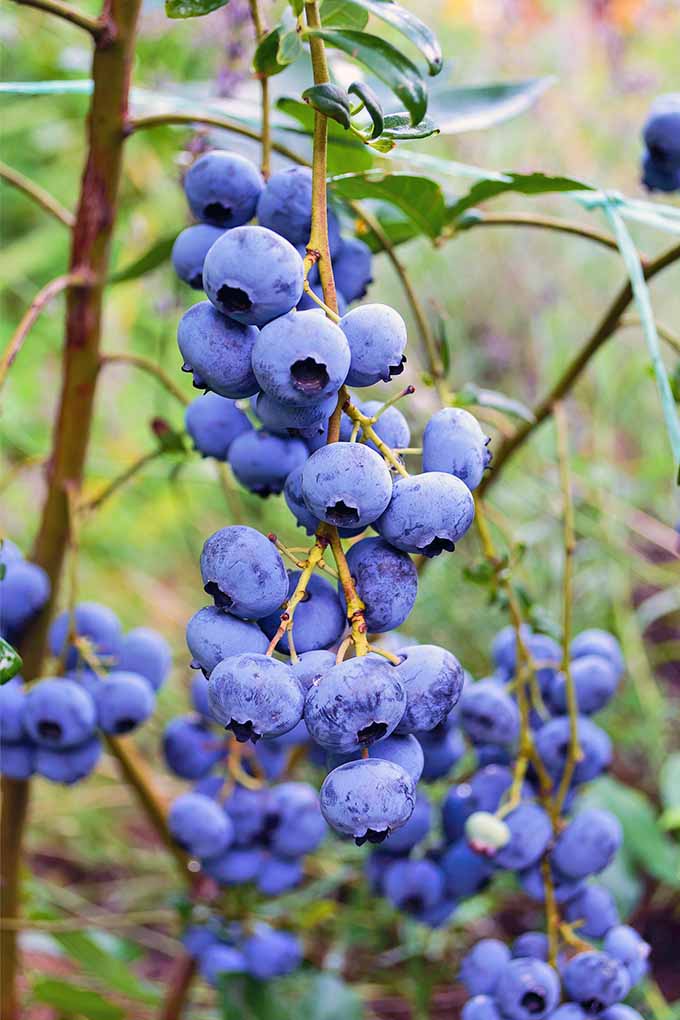
Remember that blueberries do best in acidic soil – a pH less than 5.0 is required to grow them successfully, so test your soil and amend it appropriately before you get to planting, preferably a year in advance for in-ground plantings.
Which varieties will you grow? We love hearing from you, so be sure to drop us a line in the comments below!
And for more blueberry gardening guides, be sure to check out some of our other articles such as:
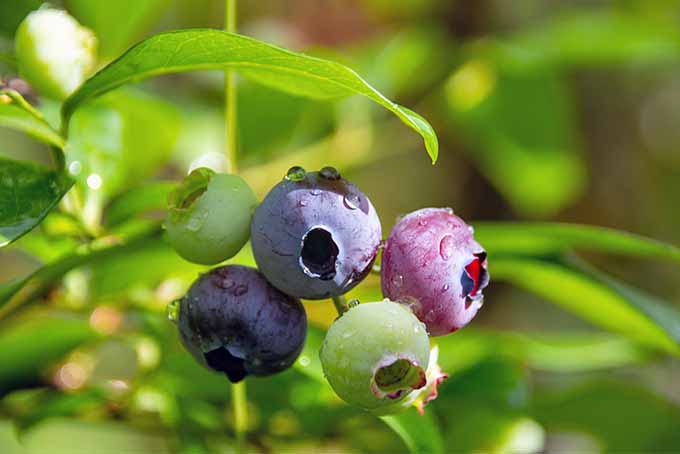
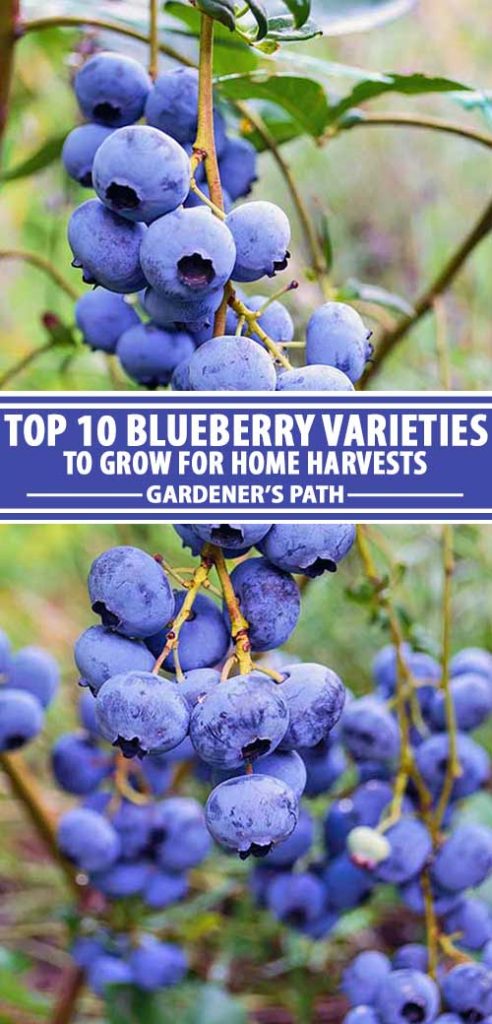
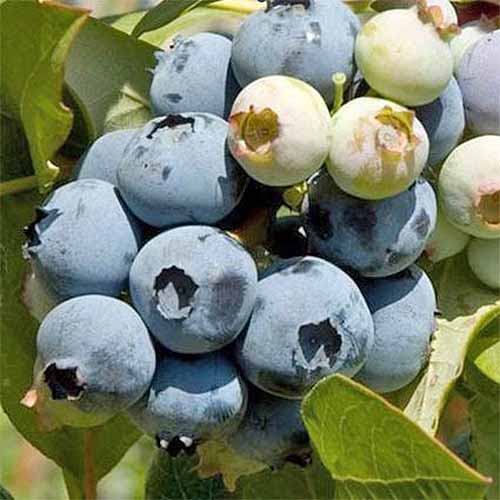
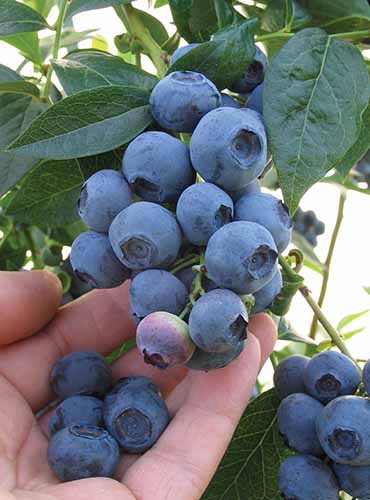
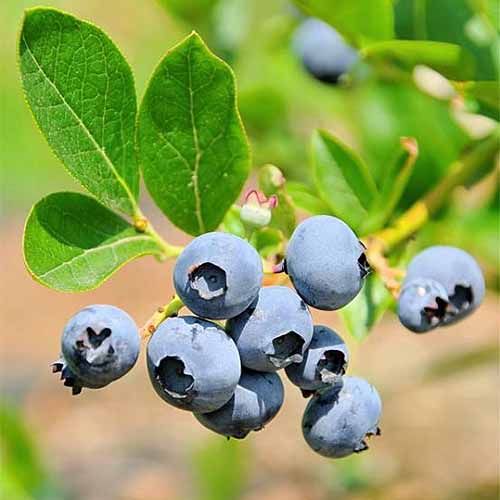
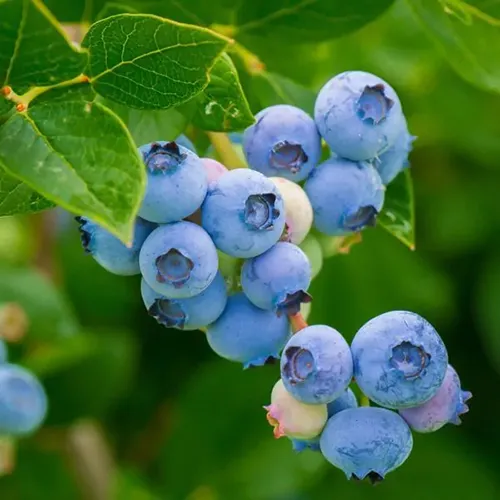

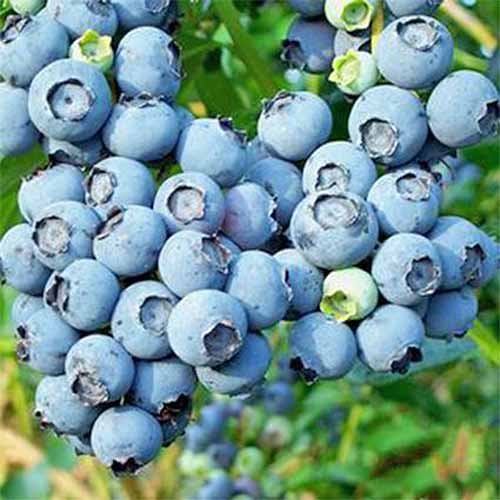
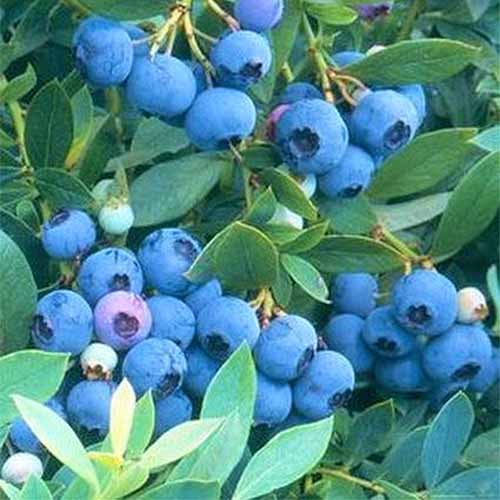
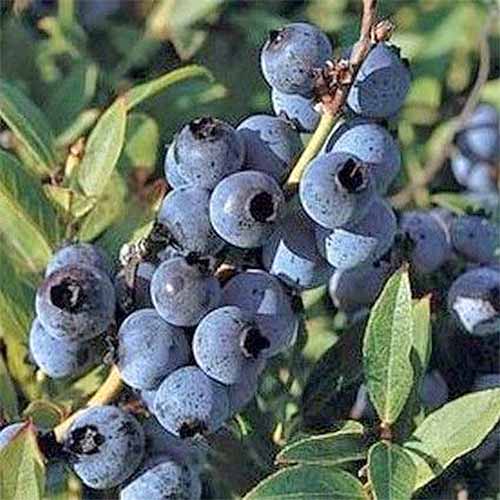
I recently bought a house that has 8 established blueberry plants but they have been neglected. We did get some blueberries… so did the birds! I plan to weed around them but I am not sure how to prepare them for winter and I don’t know what variety they are. We live in Vermont. I want to net them in the spring to keep the birds off… they get the cherries and blackberries, after all!
which blueberry variety can thrive in USA Hardines Zone 11b? like in the Philippines? tropical country? thanks
Blueberries can be difficult to grow in warmer environments because they typically require a certain number of chill hours each winter in order to produce fruit the next season, but varieties like the Biloxi Southern Highbush may produce fruit if given optimal conditions otherwise. Seek out any variety that is described as “no chill.” Happy gardening, and good luck!
I live in middle Tennessee (zone 7). I am building a house on the side of a large hill and want to plant a large variety of producing plants and trees. Blueberries are on my list of plants. I don’t personally eat them but my wife and friends do. They will most likely pick them and eat them on the spot or bring them in and put them on some desert dish. The soil is excellent and water drainage is good on the slopes. The whole area gets full sun all day. Since it is recommended to plant at least… Read more »
Good luck with the building project, Blake! Though growing on a hill introduces its own challenges, in zone 7 with the proper conditions, you definitely have some options. In Tennessee you’re actually located right on the border between selecting cultivars that require a certain number of chill hours and no-chill options. And your success with these may depend on whether you get a series of warm winters or not, so you may want to experiment and choose a few of each. ‘Bluecrop’ is a particularly popular variety, but keep in mind that it has shallow roots which may become an… Read more »
Thank you Allison. Although we will be on a hill, I will be planting on relatively level sections. I have only been here for 2 winters. They have been mild by comparison to Connecticut winters. The locals tell me this last one was pretty bad. We had 2 separate weeks were the temps dropped into the low teens. most of the time it was long sleeves and jacket weather. Mostly high 20’s and 30’s at night and 40’s to 50’s during the day. We do get a lot of rain in the late winter, early spring. I will try all… Read more »
Sounds great, Blake. Keep us posted!
Hello Allison, I have been testing blueberry cultivars for several years and have rejected ‘Top Hat’ and ‘Blue Sunshine’. They are both productive, with decent quality berries. But the over all flavor of these two are pretty weak and just about any other cultivar has better flavor. Also, ‘Top Hat’ has effectively been replaced by one of its own kids: ‘Jelly Bean’. Same heavy production, but now much better flavor and more attractive plant that change colors as the seasons progress. You’ll love it.
Awesome, thanks so much for the input, David! I know some gardeners love to see a plant that produces heavy yields, but I’m personally in the camp that will take just a few berries if they taste spectacular. ‘Jelly Bean’ sounds like a good one to check out.
‘Sunshine Blue’ has been replaced too, by ‘Peach Sorbet’. These newer plants are more expensive, but they are really worth it. Since they last for years and years, starting with good material really helps maintain future enjoyment as they grow larger and larger.
Hi all I live in the uk in a seaside town and after reading your guide I would love to try the top hat variety. Can anyone tell me when would be best time for planting and whether it is better from seeds or from plants. Thanks
Thanks for your questions, Alex! Since you’re located in a seaside town in the UK, your region is probably comparable to USDA Hardiness Zone 9 (though I would recommend that you do the research on that to confirm, based on your local climate conditions). ‘Top Hat’ might not be the best pick for your area, since it’s more suited to USDA Hardiness Zones 4-7. If you’re looking for another dwarf variety, you might want to consider ‘Pink Icing,’ or even ‘Sunshine Blue’ – though this cultivar is not a dwarf variety, it does well in small spaces and containers. Though… Read more »
Hi Allison, I have about 9 blueberry plants left. I had more but between the dog digging them up and getting mowed over that’s all that I have left. I have Blue Ray,Blue Jay, Blue crop and a few others. My issue is caterpillars. Not eating the shrub but inside the berry. I’m ready to let the birds have them all! It’s really wearing me out trying to get rid of them. We love blueberries but I don’t know why this is happening to us. Every person I speak to says they don’t have them. My guess is they don’t… Read more »
Oh no! Sorry for your loss! Too bad about the lawnmower and the dog attack. As for the insects that you described, what do they look like more specifically? You mentioned flies- have you also seen moths around your plants? They can be difficult to spot, since they are only active at night. It doesn’t sound like you are doing anything wrong, but rather, your blueberries look good to eat to these bugs! And you’re right- there’s a chance that your neighbors may have them too, but they can sometimes be hard to spot. Or perhaps they are growing cultivars… Read more »
What type do you recommend for higher elevations? I live in Zone 6, New Mexico, at just over 7000 feet elevation.
Highbush varieties are known for doing well at higher elevations- try ‘Legacy,’ ‘Duke,’ ‘Patriot,’ or ‘Blueray.’
I live in the southern part of the San Joaquin valley here in CA. I am trying to grow blueberries for health reasons for my wife who has RA. A local gardening operation sold me 6 plants, two of two kinds and one each of other varieties. The varieties are Misty, O’Neal, the cross pollinator, Pink Lemonade and Jubilee. Now I know growing them here is a chore as we are in ZONE 10 and all but one of the plants made it. The folks think the reason the one did not is due to some weed and feed fertilizer… Read more »
I’m so happy to hear that most of your blueberries made it through to another California spring (and a wet one, at that)! As I’m sure you know, part of what makes growing blueberries in warmer growing zones so difficult is the fact that most cultivars require a certain number of chill hours to produce a good harvest with high yields. Southern highbush varieties in particular do better in warmer zones since they have low chill hour requirements. In some cases, zero chill hours are required to produce a harvest. ‘Misty’ and ‘O’Neal’ are both early Southern highbush cultivars, ‘Jubilee’… Read more »
Hi. I live in Kingston, Ontario, Canada and have only one blueberry plant. I originally had two, but one died. One was Blue Ray, the other was Blue Crop, but I’m not sure which one I still have. I planted them in the fall of 2017 and they have not yet produced fruit. The existing plant is very small and I’m wondering if I need to get another blueberry plant for cross-pollination purposes. If so, how do I know which kind to get when I don’t even know which one I currently have? Do you have any suggestions?
So sorry to hear that you lost one of your plants, Lorna. Blueberries typically take 3-4 years to produce fruit, so hopefully you’re in for a treat this summer! Both ‘Blueray’ and ‘Bluecrop’ are self-fertile, mid-season Northern highbush varieties that do well in cold climates. Though planting two in close proximity for cross-pollination isn’t required to get a harvest, doing this can result in higher yields. It can be hard to tell one blueberry from another unless you’re able to compare the flowers or fruit side by side. But you could opt to plant another pollinator altogether near your remaining… Read more »